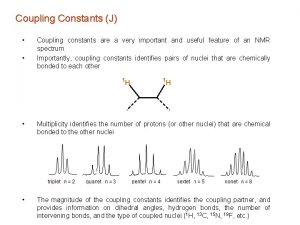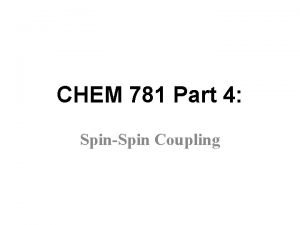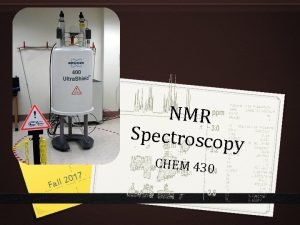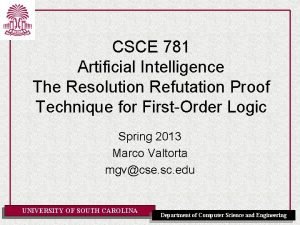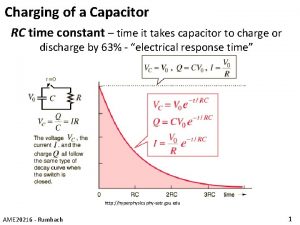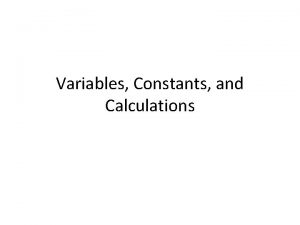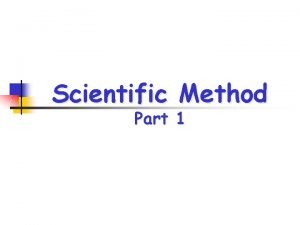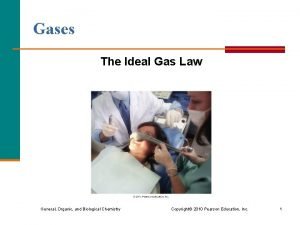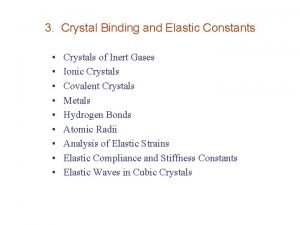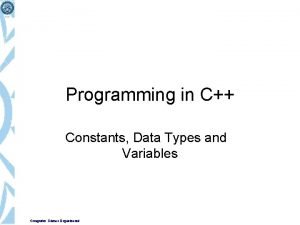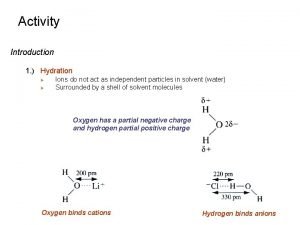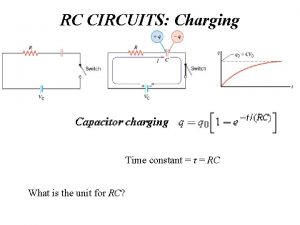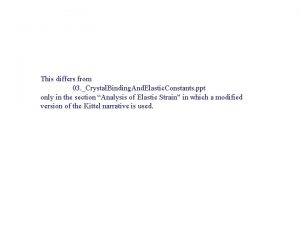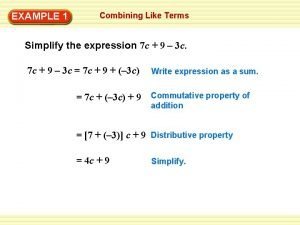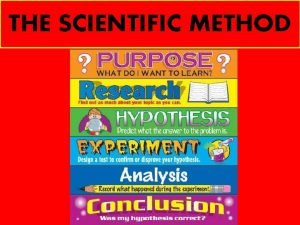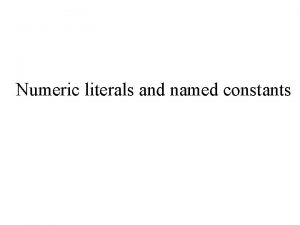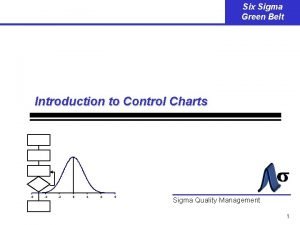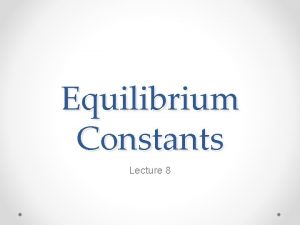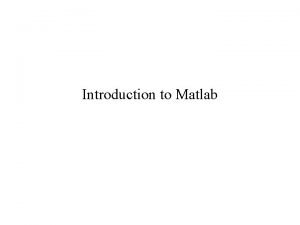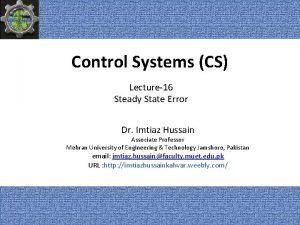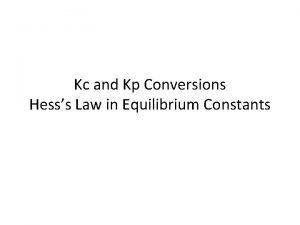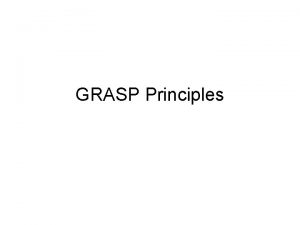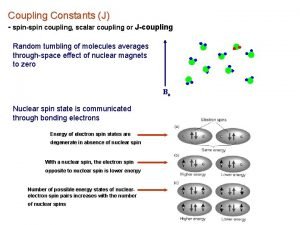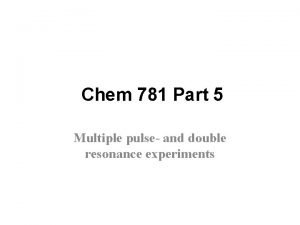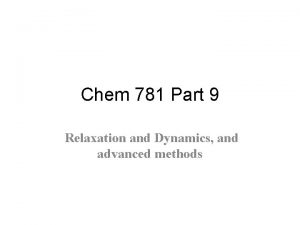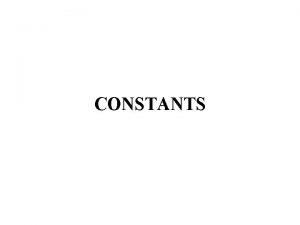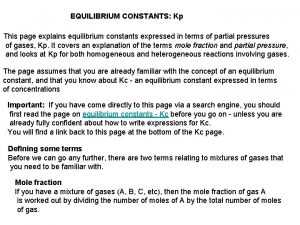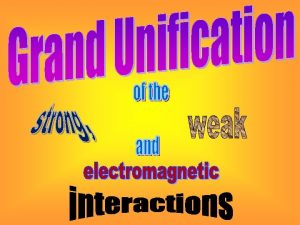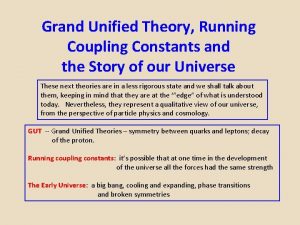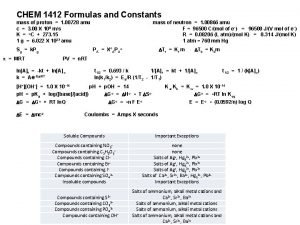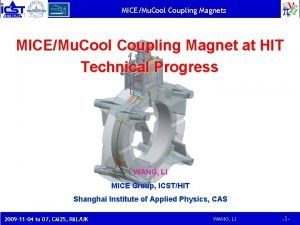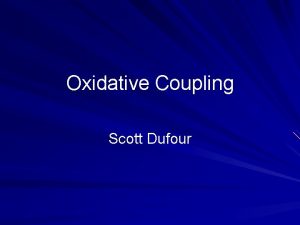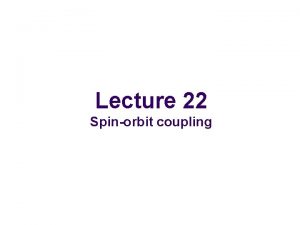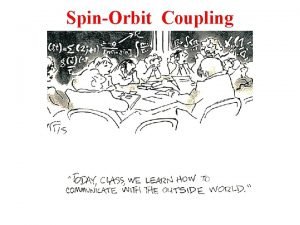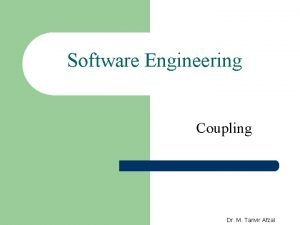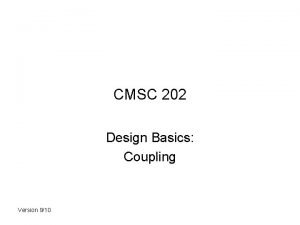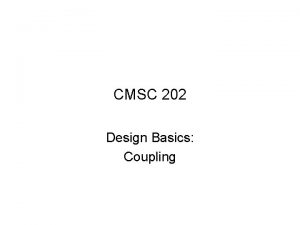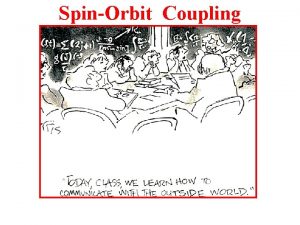Chem 781 Part 7 Coupling constants from COSY






























- Slides: 30

Chem 781 Part 7 Coupling constants from COSY experiments

Operators for two spin system • • • For a two spin system there will be operators involving both one and two spins. The one spin operators which are equivalent to the vectors describing x, y, or z magnetization. For two coupled spins IA and IB there is a total of 24 = 16 possible operators: Iz. A, Ix. A, Iy. A, Iz. B, Ix. B, Iy. B (6) z, x or y magnetization of spin A or B (same as in vector picture) Ix. A Iz. B, Iy. AIz. B, . . . (4) antiphase magnetization for spin A coupled to spin B Ix. A Iy. B, Ix. A Ix. B, . . . Iz. A Iz. B (4) (1) 1 (1) double and zero quantum coherence of spin A and B longitudinal spin order (population inversion of A relative to B) unity operator (needed for mathematical reasons)

Rules of rotation starting from an initial state All interconversions between operators can be regarded as rotations, giving a sine and a cosine component: Initial state • rotation operator = cos component(initial) +sine component(new) • each component of a two spin operator can be treated separately • if initial state is perpendicular to rotation axis, it will change as a cosine, and a new state will emerge perpendicular to rotation axis and initial state with a sine dependence. Sense of rotation given by right hand rule (note that some books use left hand rule). • If initial state parallel to rotation axis, it will remain unchanged. • Only the one spin operators (Iz, Ix, Iy ) will give rise to an observable


Product Operator Description of COSY experiment (90 )x t 1 (90 )x acqu It can be shown that simultaneous coupling and shift can be treated in sequence. Thus the following sequence of four rotations has to be considered: 90 x. A, B → (ΩA, B t 1)z → (π JAB t 1)zz → 90 x. A, B • As each rotation creates two components, the number of terms will increase exponentially with the number of steps. • Fortunally, 90 pulses retain only the sine component, simplifying the analysis.

COSY part 1: 90⁰ pulse – t 1

COSY part 2: Effect of second pulse

COSY party 3: acqusition

Summary COSY • Always two sets of signals occur: Diagonal peaks (same W during t 1 and t 2) and cross peaks (W A during t 1 and W B during t 2 or vice versa). • Diagonal peak in phase doublet cos(p JAB t) in both f 1 and f 2, cross peak anti phase with respect to JAB in both f 1 and f 2 sin (p JAB t) • Cross and diagonal peaks 90 out of phase in both f 1 and f 2: III is along x and IV is along y axis at beginning of acquisition. • . To avoid problems of dispersion peaks along the diagonal, the basic COSY spectrum is typically displayed in magnitude mode. That results in a loss in resolution and prevents accurate coupling constants to be measured.

Double Quantum filtered COSY • Adding a third 90 pulse to the COSY experiment allows the double quantum term (II) to be converted into antiphase magnetization, which will evolve obsevable magnetization during acquisition: • Application of a four step phase cycle allows one to select only signal derived from this DQ term: define: cos(ΩAt 1)≡c. A sin(ΩAt 1) ≡ s. A cos(πJAB t 1) ≡ c. J sin(πJABt 1) ≡s. J (I) (III) (IV) scan 1: (+) Iy. A c. Ac. J -Ix. AIz. B c. A s. J Ix. A s. A c. J Iy. A Iz. B s. A s. J scan 2: (-) Iy. A c. Ac. J Iz. AIx. B c. A s. J Iz. A s. Ac. J -Iy. A Ix. B s. A s. J scan 3: (+) Iy. A c. J -Ix. AIz. B cas. J -Ix. A s. A c. J -Iy. A Iz. B s. A s. J scan 4: (-) Iy. A c. J Iz. AIx. B c. As. J -Iz. A s. A c. J Iy. AIx. B s. A s. J ────────────────────── total: 0 -2 (Iz. AIx. B + Ix. AIz. B) c. A s. J 0 0

One can show that this will result in diagonal and cross peaks both in anti phase and equal phase: • The first part of the sum (Iz. AIx. B ) will give a cross peak, the second one (Ix. AIz. B) will give a diagonal peak. Both are modulated with a sine of JAB ( antiphase) and cos of ΩA (absorption) during t 1, and will start in antiphase during acquisition, hence will be antiphase with respect to JAB also during t 2. • Thus a phase sensitive spectrum can be acquired in which both the diagonal and cross peaks can be phased. In addition, all singlet peaks will be suppressed as they will not evolve any DQ terms. • Gradients can be used to select the double quantum term in one scan and allow for very efficient suppression of singlet signal, including water signals

DQF COSY with gradient selection • Typically only two step phase cycle needed • Effective singlet suppression (water signals) • For resolution of couplings, more points taken as in basic COSY (512+)

Appearance of DQF spectra: Two spin system

Three spin system: • Now two types of coupling have to be considered: The coupling between the two spins comprising the cross peak is called the active coupling. All other couplings are referred to as passive couplings (they give additional splitting of the cross peak). • active couplings give an anti phase splitting • passive couplings give in phase splittings • Note that active and passive coupling are different for each cross peak. • Up to 16 lines can occur for a multiplet .

Linear three spin system

General three spin system

Complexity of DQF-COSY spectra • Four spin systems • Cancellation of lines Two couplings to chemical non equivalent partners can become very similar. If one occurs as active and one as passive coupling positive and negative lines can overlap and partially or completely cancel Simplification of multiplet patterns is thus often a necessity. It can be obtained by obtaining enhanced COSY (E-COSY) spectra

H-1/H-16 cross peaks of the DQFCOSY spectrum of menthol. Some lines are greatly decreased in intensity due to cancellation.

Small couplings and accuracy • When the coupling constant becomes comparable to the line width (small coupling or broad lines) measurement of coupling constants will become less accurate. • Thus a method which would separate the individual multiplet lines would improve accuracy of coupling constant measurements. Again this will be possible to some extent by using the enhanced COSY method.

Experimental considerations Regular COSY: • • Optimized for low resolution as no fine structure of cross peaks needs to be resolved td[f 1] = 64 - 128, can be performed in as little as 5 -10 min for concentrated samples magnitude display, no need for phase correction gives basic H-H connectivity information only DQF-COSY (or P. E. COSY): • • Designed to resolve multiplet fine structure of cross peaks. td[f 1] typically = 512 or larger. Takes one to several hours to run. Phase sensitive and will therefore require manual phase correction for useful results Should only be attempted when coupling constant information is to be extracted from 2 D spectrum. EXCEPTION: Need for suppression of strong singlet peaks (H 2 O samples) or cross peaks close to diagonal

Enhanced COSY (E-COSY): General principle Consider a system of three spins A, B, C coupled to each other by JAB, JAC and JBC. In general any experiment correlating spins A and B without exciting the common coupling partner C will only result in peaks connecting multiplet lines with C in the same spin state, as no transitions from IαC to IβC (or vice versa) take place between t 1 and t 2.

E. COSY in HSQC and HMQC spectra • If A, B and C are all different nuclei a correlation of A and B via HSQC or HMQC will show E. COSY type peaks from coupling to C.


1 H{13 C} HSQC spectrum of Cp*Rh(Cp. Co)2(μ 2 -CO)2. The large passive 13 C-103 Rh coupling allows the small 1 H 103 Rh coupling to be observed even when it is not resolved in the 1 D 1 H spectrum (HB). . One can see that 2 JHB, Rh has the same sign as 1 JC, Rh whereas 2 J HA, Rh has the opposite sign. If one assumes 1 JC, Rh > 0, then 2 J 2 HA, Rh < 0 and JHB, Rh > 0.

E. COSY in COSY spectra • If A and B are of the same isotope (usually 1 H) and C is a hetero nucleus the cross peaks in 1 H/1 H COSY spectra will be split in an E. COSY type fashion by the passive couplings A-C and B-C. In the example (COSY spectrum of Ph 2 P=CHA-CHBR 2)the passive coupling is to a 31 P nucleus:

Homonuclear spin systems and P. E. COSY • An E. COSY type pattern in 1 H/1 H COSY would simplify the patterns observed in DQF-COSY spectra. However, in homonuclear spin systems all pulses will be applied to all nuclei. • It can be shown if the second 90 pulse in the COSY experiment is replaced by a pulse smaller than 90 than correlations between lines with the passive coupling partner in different spin states are much weaker than the ones between equal spin states: In order to solve the problem of the out of phase diagonal encountered in the two pulse COSY experiment a phase cycle is employed to subtract the diagonal: • (90 )x, x ── t 1 ── (18 )x, x (18 )x, -x acquisitionx, -x(add, subtract) • By splitting the second pulse in two one performs one scan with 18+18 = 36 (cross and diagonal) and subtracts the spectrum with 18 -18 = 0 (diagonal only). That results in a spectrum with a reduced diagonal which can be acquired in a phase sensitive fashion and which will exhibit E-COSY type multiplet patters. • This experiment is called P. E. COSY for Primitive Enhanced COSY (implying that there is a better but also more complicated way to achieve such a spectrum).

Use of coupling information to determine conformation • In the two possible boat conformations, the OH and i-Pr groups can be either axial (a) or equatorial (b) positions. • Proton H-1 and H-2 will than be either both in equatorial (a) or axial (b) positions.

• Analysis of the coupling pattern of H-1 reveals the presence of two large ( >10 Hz) coupling constants, with is only possible for pairs of trans-axial/axial pairs of nuclei, indicating that b is the structure present.

• Analysis of the H-1/H-6 A and H 1/H-6 B cross-peaks in the P. E. COSY spectrum allow an assignment of the coupling constants to specific protons. • 10. 0 Hz for 3 J 1, 2 • 4. 1 Hz for 3 J 1, 6 A • 10. 8 Hz 3 J 1, 6 B. • That also allows and assignment of H-6 A as equatorial and H-6 B as axial proton.

Analysis of the H-6 A/H-6 B cross peak results in: 3 J 6 A, 1 = 4. 1 Hz 3 J 6 A, 5 = 3. 7 Hz 3 J 6 B, 5 = 11. 6 Hz • The C-10 methyl group is also in an equatorial position (H-5 is axial), proving the relative stereochemistry on centers C 1, C 2 and C 5. • Only the P. E. COSY allows for a useful analysis of the cross peak fine structure.
 J coupling constant
J coupling constant Geminal and vicinal coupling constants
Geminal and vicinal coupling constants Factors affecting chemical shift
Factors affecting chemical shift Geminal coupling
Geminal coupling Organometallic
Organometallic Ai 781
Ai 781 Calhr 781 form
Calhr 781 form Ngic 888-781-0585
Ngic 888-781-0585 888-781-0585
888-781-0585 Rc time constants
Rc time constants Marc overmars game maker
Marc overmars game maker Const in c#
Const in c# Constant in scientific method
Constant in scientific method Constant in avogadro's law
Constant in avogadro's law Universal gas constant value in si units
Universal gas constant value in si units What is crystal binding
What is crystal binding Variables
Variables Equilibrium constant activity
Equilibrium constant activity Rc time constant
Rc time constant Crystal binding and elastic constants
Crystal binding and elastic constants Constant term
Constant term Constants in scientific method
Constants in scientific method Named constants
Named constants Walter shewhart
Walter shewhart Manipulating equilibrium constants
Manipulating equilibrium constants Matlab constants
Matlab constants Elastic strain and plastic strain
Elastic strain and plastic strain Acceleration error constant is defined as
Acceleration error constant is defined as Kc to kp conversion
Kc to kp conversion 9 principle of grasp
9 principle of grasp Ventral respiratory group
Ventral respiratory group
